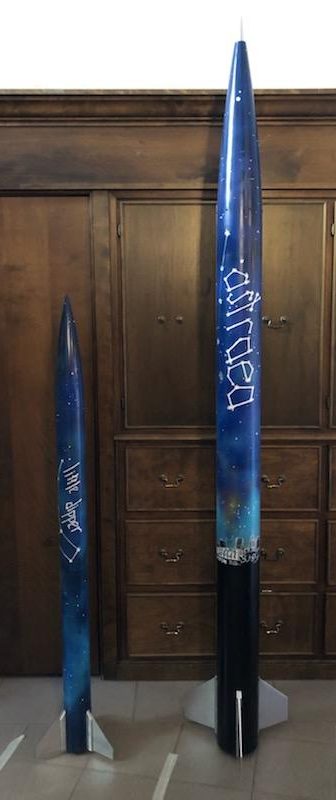UA Student Rocket Design Team Heading to NASA Competition
The Akronauts will compete in the NASA Student Launch Competition to improve research and development for the Space Launch System and to gain hands-on experience in the field.
(Video via The University of Akron)

(Image via The University of Akron)
Akronauts Adam McElfresh (left) and Matthew Reppa, along with Chris Pearson, the team’s mentor, load their rocket onto the launch rail, which keeps the rocket going straight as it initially builds up speed. This test launch was held at the National Association of Rocketry field located in Amherst.
April 1, 2019
The University of Akron’s student rocket-design team, the Akronauts, will be competing in NASA’s 2019 Student Launch Competition in Huntsville, Alabama from April 4-6.
Founded in 2014, the Akronauts are comprised of students from the College of Engineering. Through hands-on experience, the students receive the ability to not only improve aerospace technology, but also their knowledge of the field.
“The goal is to place at the annual NASA Student Launch initiative held every spring,” their description on a UA webpage said.
According to a University press release, they are one of four teams from universities in Ohio that will participate in the competition in order to increase research and guidance in the payload and airframe development.
As the leader of the 91-member team, sophomore Matthew Stanko, an aerospace systems engineering major, said they are just as honored as before to be accepted into this highly prestigious competition.
“This year, we are striving to improve upon what we’ve been learning in our short time as a design team. With the total success of all three test launches, we are more energized and ready to conquer this competition,” Stanko said.
According to NASA’s website, the competition is a research-based project aimed at providing additional research and development to the Space Launch System.
While participation is limited to colleges and universities in the United States, those selected to compete go through eight months of designing, building and flying different payloads that support SLS.
In applying for the competition, Akronauts team members had to include a 90-page report with details on technical designs, project plans, budgets and more before working on the rocket for competition, the press release said.
After being selected to compete in October 2018, the Akronauts started the eight-month process of designing and testing a rocket to outperform others before the challenge near NASA’s Marshall Space Flight Center.

The Akronauts’ preliminary design, named Astraea (right), will reach heights of 4,900 feet. The team worked with Mac Love at Art X Love in Akron to have a custom paint job that will capture the essence of the rocket, the Akronauts and the city of Akron. The smaller rocket on the left, named Little Dipper, was the team’s subscale test rocket.
Dr. Frank Loth, faculty advisor and mechanical engineering professor, said that the UA student rocket team has grown to become nationally competitive due to their hard work even though it has only been around for five years.
“In addition, the team puts in many hours working with K-12 students to educate them about rockets as well as to explain the excitement that comes from learning about science,” Loth said.
During the competition, teams will be awarded points for their rocket’s performance and additionally judged on “altitude, payload and other factors,” the press release said.
However, NASA has included a new performance measure to the competition this year. In the past, teams aimed to get their rocket the closest to one mile above the ground level.
Now, teams will predict their rocket’s flight altitude and points are awarded if it goes “between upward of 3,500 and 6,000 feet,” according to the press release.
Since this is not the Akronauts first time attending the competition, they are hopeful about their ability to place high in the competition. Two years ago, their Zaphod rocket design took 13th place.
To follow the progress of the Akronauts, visit their Facebook, Twitter and Instagram pages. Videos of their tests flights and more are also available on YouTube.












